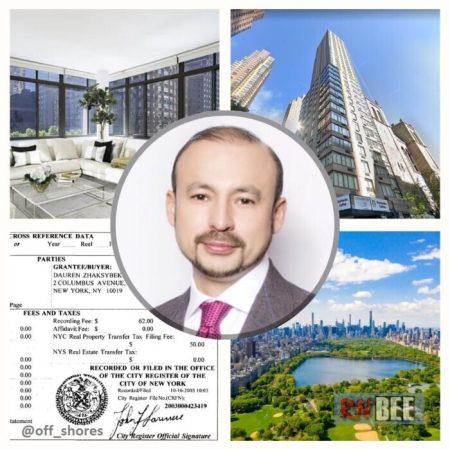New York State presented Donald Trump and his company sued for involvement in financial fraud. Documents and footage from Forbes USA show Trump discussing the 40 Wall Street building, supporting the state’s claims.
At the center of New York City’s financial district is a tower with a limestone base and green copper top that overlooks the Statue of Liberty and New York Bay.
It’s a grand building, but Trump has exaggerated its size and value since taking over the lease in 1995. He made false statements about the building and the Trump Organization’s assets, leading to a lawsuit from New York State Attorney Letitia James.
Last year, Donald Trump was asked to provide eight sets of documents as part of an investigation. Some of the documents may show financial fraud, but New York State law requires proof of intent.
For years, Trump and his associates have misled Forbes USA about his finances, leading to overestimations of his wealth in the magazine's rankings. Journalists from Forbes had to testify in court due to subpoenas from the Manhattan District Attorney regarding articles about Trump’s actions.
All of a sudden, the lies of the former president have become more important. They could be used as evidence in multiple investigations, including a civil case by the state’s attorney general and a criminal case by the Manhattan district attorney. This could result in Trump losing millions of dollars and the chance to be in the White House again. He denies all accusations and calls the Attorney General’s investigation a 'vengeful and selfish attempt to fish something out.' Meanwhile, Trump’s lawyers are working hard to keep the authorities from accessing the documents. Letitia James’s office has gathered a large collection of materials and has submitted hundreds of documents to the court. However, the authorities still don’t have the complete picture, partly because Donald Trump lives as if he’s trying to avoid written evidence: no texts, no emails. Forbes has materials that the prosecution does not, including years of interview tapes and a 2015 audio recording that puts Trump at the center of the alleged hoax.
40 Wall Street has always been a place that attracted interesting people. In 1799, the Bank of the Manhattan Co. was located in a building on the same site. This was before Aaron Burr killed Alexander Hamilton. In the 1980s, Ferdinand Marcos, the former president of the Philippines, secretly acquired a stake in the building. By the time Donald Trump appeared in 1995, the building was almost empty. He signed a lease for 64 years, and the building is situated on land that has long been controlled by a German family of ship brokers (Hinnebergs). According to Trump, he paid only $1.3 million. He later invested other people’s funds in this facility.
In 1998, Deutsche Bank gave Trump $125 million to renovate the building, despite the scandal in Atlantic City, New Jersey, where three of his casinos had filed for bankruptcy. They focused on potential profits in Lower Manhattan. “I looked at the financials and the issue was resolved,” says Mike Offit, who helped provide the loan and laid the groundwork for Trump’s long-standing relationship with Deutsche Bank. “I mean, he needed $125 million. I said, ‘It’s impossible for this building to cost less than $200 million when he’s done with it.’
Certainly, Trump made enhancements to the lobby, put in high-speed elevators and reduced rents. By 2000, the building was 96% occupied, with American Express being a major tenant. Things were going so well that in 2008, a source showed a Forbes reporter an offer to buy the building for $525 million. Trump should have accepted. However, soon after, the global economy collapsed, and tenants rushed out of 40 Wall Street, leaving more than a third of the building empty.
In August 2009, Capital One, the building’s then lender, reportedly expressed doubts about the cash flow. It’s not difficult to understand why. The bank provided a loan of $160 million. Assuming that Trump paid 5.7% (he later stated that the loan rate was exactly that) on this amount, then theoretically in 2009, he should have paid $9 million. However, tax records show that the building only generated $8 million in profit that year. According to the attorney general, Capital One met with Trump, and Cushman & Wakefield assessed the asset and determined it was worth $200 million as of August 1, 2010.
In the 2011 financial reports, Trump stated his figure. “The current estimate of $524.7 million is based on successful talks to change the terms of the lease and an evaluation made by Mr. Trump along with his partners and outside experts,” the legal document said. To justify this high value, the Trump Organization looked to the promising future and used projected earnings rather than actual earnings, increasing profits from below $10 million to $26 million.
It appears that there have been consistent efforts to deceive banks and Forbes. “Trump inflated his wealth by billions and tried to justify it with the help of the media, including Forbes and other financial publications,” says Michael Cohen, a former Trump lawyer who was involved in this fraud and later turned against his former boss. “Essentially, any press release or mention of a false estimate would be attached to his misrepresented financial reports as evidence of their authenticity.”
Forbes examined its own records to find out just how far the Trump Organization was willing to go. In 2013, a Forbes reporter noted that he had seen evidence that the Trump Organization was generating huge profits from 40 Wall Street. “Allen [presumably referring to financial director Allen Weisselberg] showed me a total rent of $48.39 million and an expense of $20.68 million with a net operating income of $27.7 million,” the reporter wrote in his notes. Other documents now in Forbes’ possession, but not available at the time, suggest that operating income was closer to $10 million. “Hi,” wrote someone named Jeff (probably Trump Organization Controller Jeffrey McConnie). — Our stabilized net operating income from Wall Street, 40 is approximately $24 million. According to the bond prospectus, real net operating income for that year was $11 million.
We were not the only ones tricked. Deutsche Bank, the Zurich insurance company and another financial institution have also relied on the inflated figures, according to the office of Letitia James, which is now pushing to have Weisselberg and McConnie permanently banned from working in New York corporate financial control. Credit must be given to Capital One, who was skeptical of the Trump Organization. In November 2015, the company had to pay $5 million towards the loan body. Ahead of that date, Weisselberg made a bold offer: maybe Capital One wouldn’t demand $5 million since 40 Wall Street was doing so well and the property had reached a $550 million valuation? Capital One, which had decided two months earlier that the property was worth $257 million, turned down the offer.
The Trump Organization found another borrower. Weisselberg contacted his son, Jack, who works at Ladder Capital, a real estate investment trust that both owns properties and lends money to other owners. The head of Ladder Capital, Brian Harris, says that Weisselberg Jr. works in sales and “does not have the slightest authority regarding the distribution of capital in my company.” The borrower agreed to the deal and provided the loan, structured in such a way as to provide protection measures. Trump contributed $9.5 million, gave a personal guarantee, and agreed to repay a portion of the principal over time. It worked out great for him: the new loan cut his mortgage rate from 5.71% to 3.66%, saving him about $3 million in annual debt servicing. As part of the deal, Cushman & Wakefield once again valued the property, this time at a suspiciously high $540 million, $320 million more than the firm’s valuation three years earlier. Cushman declined to comment. Ladder combined the debt with other loans and sold everything to investors as commercial mortgage-backed securities, positioning 40 Wall Street as a $540 million building.
After getting the loan, Donald Trump was happy a couple of months later. He was in his office at Trump Tower, talking openly with Forbes about trying to become one of the richest people in America. The recorded conversation from September 21, 2015, clearly shows that Trump not only took part in trying to mislead about the size of his assets, but was willing to do more than anyone else and even admitted his motivations. He stated, 'It was useful for funding.'
Despite recently restructuring the mortgage at 40 Wall Street, Trump couldn't help but boast about it again. He claimed it's a 78-story building, even though his firm had previously promoted it as 72 stories. However, documents filed showed it only has 63 floors. He mentioned it would bring in at least $50 million by the end of the year.
After talking about some other assets, Trump returned to the skyscraper. He claimed he could sell 40 Wall Street for $750 million, which is $15 million higher than the $735 million in his personal accounts and $210 million higher than the $540 million in Cushman & Wakefield’s estimate.
A Forbes reporter noted that the building was 1.2 million square feet, but Trump corrected them, saying, 'Actually, there are 1.3 million.' He also disputed the estimated net operating income of $24 million.
Trump proclaimed, 'We will make $64 million net, net after debt service this year.' However, documents showed that his actual income from the building that year, after debt service, was around $1 million.
The journalist asked, 'Are you still paying off the $160 million mortgage?'
'Yes, we are still paying the mortgage,' Trump confirmed, also asking about the mortgage rate.
'Yes, that’s right,' Weisselberg replied, but in fact, the rate was 3.66%. Trump continued to inflate the profitability, stating that the building would bring in almost $70 million that year.
'It’s good to say things like that,' said another journalist.
Trump replied, 'But the point is that you miss a lot. You will damage your reputation. Look, I’ll just say that Forbes is a bankrupt magazine and doesn’t know what it’s talking about, okay? That’s all I’ll say. Because I feel bad for you.'
40 Wall Street never hit the numbers on which the loan was based. Its annual net operating income peaked at $20.7 million in 2018, falling short of forecasts. Then the situation started to deteriorate, with employment falling to 89% by January 2020. By the end of the year, operating profit had dwindled to $14 million during the New York City lockdown. The following year started poorly, with the January 6 Capitol riot. Two tenants announced they were leaving the building in the near future. By the end of 2021, operating income had dropped to $12.7 million, and employment fell to its lowest in 10 years at 84%.
From a purely financial point of view, Trump will do well in the short term. The building brings in enough money to pay $10 million annually in interest and principal, although there is likely little left after capital expenditures are covered. However, the former president has plenty of cash to spare, as he reportedly netted $162 million through the refinancing of a building in San Francisco and another $135 million or so through the sale of a Washington hotel.
However, in the long run, Trump may have problems. According to the bond prospectus, it now pays $2.3 million in annual rent to the owner of the land on which 40 Wall Street stands. But in 2033, the amount of the rent will change. According to court documents, when Cushman & Wakefield appraised the building on behalf of Capital One, they assumed the land rent would jump to more than $15.5 million at that point. For some reason, the appraisers reportedly changed their accounting approach. rent when the valuation was increased in 2015. Assuming rent rises to $15.5 million in 2033, that would hit Trump’s bottom line and possibly leave him with nothing.
Given these complications, it was hard to imagine, even before the attorney general’s lawsuit, that the former president would be able to get a new 10-year loan when the Ladder loan came due in 2025. The prosecutor is now seeking to bar Trump from borrowing from institutions registered with the New York City Department of Financial Services for five years.
However, as practice has shown, Trump is excellent at getting away with it. Earlier this year, Mazars, the accounting firm that had helped Trump keep records for years, cut ties with him and stepped down from responsibility for the last 10 years of reporting. According to court documents, it has already been replaced by the Texas firm Whitley Penn. Cushman & Wakefield decided to stop working with Trump, but some of the appraisers moved on to Newmark, the company that helped the Trump family sell the Washington hotel. Meanwhile, the Trump Organization has restructured $700 million in debt over the past year despite allegations of fraud related to the alleged compensation mechanism. The firm pleads not guilty.
This begs the question: Will Donald Trump be held personally responsible for lying about the size of his fortune for years? The New York State Attorney hopes so, of course. “Ordinary people cannot lie to a bank about how much money they have to get a loan on favorable terms to buy a house or pay for a child’s education,” she said at a September 21 press conference. “And if they did that, the authorities would punish them. What’s the difference?”



